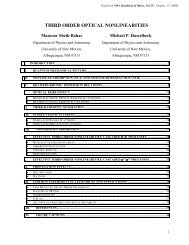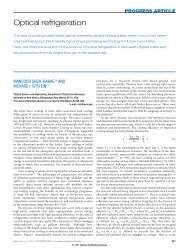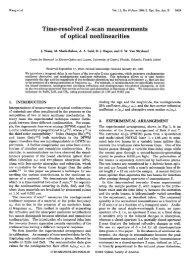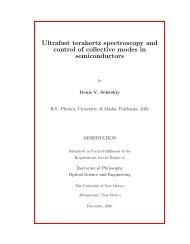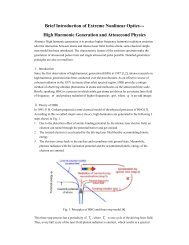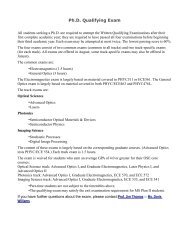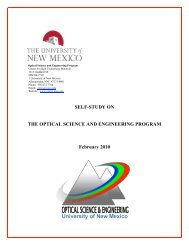Semiconductor Saturable Absorber Mirror (SESAM)
Semiconductor Saturable Absorber Mirror (SESAM)
Semiconductor Saturable Absorber Mirror (SESAM)
Create successful ePaper yourself
Turn your PDF publications into a flip-book with our unique Google optimized e-Paper software.
Instructor: Prof. Mansoor Sheik-Bahae<br />
<strong>Semiconductor</strong> <strong>Saturable</strong> <strong>Absorber</strong> <strong>Mirror</strong><br />
(<strong>SESAM</strong>)<br />
Yule Zhang & Yanrui Zhao<br />
List of content:<br />
1. General Introduction<br />
2. Overview of Different <strong>SESAM</strong> Designs and Parameters Control<br />
3. Q-switched Mode-Locking vs. CW Mode-Locking<br />
4. <strong>Semiconductor</strong> <strong>Absorber</strong> in Ring Lasers<br />
5. Conclusion and Future work
1. General Introduction<br />
Since 1992, semiconductor saturable absorbers have become the important components in the compact<br />
mode-locking solid-state lasers [1]. This invention offers the possibilities for passive pulsed solid-state<br />
laser systems, extending from Q-switched pulses in the nanosecond and picosecond regime to modelocked<br />
pulses from 10’s of picoseconds to sub-10 fs. In this report, we will review the theory and designs<br />
of semiconductor saturable absorber mirrors (<strong>SESAM</strong>) and focus on some specific topics such as<br />
structure design of the <strong>SESAM</strong> and parameters control, Q-switched mode-locking vs. CW mode-locking,<br />
and finally talk briefly about its extended application in ring lasers.<br />
Mode-locking is one of the most popular techniques<br />
to obtain ultrashort pulsed lasers. Lasers with multigigahertz<br />
repetition rates are key components of many<br />
applications. They are used in high-capacity<br />
telecommunication systems, photonic switching devices,<br />
and optical interconnections and for clock distribution<br />
etc. Figure 1. shows the history of mode-locking<br />
technology since 1960 [2].<br />
A saturable absorber is a material that has decreasing<br />
light absorption with increasing light intensity. The key<br />
parameters for a saturable absorber are its wavelength<br />
range (where it absorbs), its dynamic response (how fast<br />
Fig. 1. History of mode-locked pulsed laser technology [2]. it recovers), and its saturation intensity and fluence (at<br />
what intensity or pulse energy density it saturates).<br />
<strong>Semiconductor</strong> materials, however, can absorb over a broad range of wavelengths (from the visible to the<br />
mid-infrared). We can also control their absorption recovery time and saturation fluence (typically 1 to<br />
2<br />
100mJ<br />
/ cm ) by altering the growth parameters and device design. The <strong>SESAM</strong> is a saturable absorber<br />
that operates in reflection, thus the reflectivity increases with higher incoming pulse intensity [3].<br />
During the past decade, the device design, fabrication process and long-term device reliability have been<br />
significantly improved. There are <strong>SESAM</strong> designs that can cover wavelengths from 1600<br />
nm, pulsewidths from femtoseconds to nanoseconds, and power levels from milliwatts to >100 watts.<br />
Fig. 2. a) How does semiconductor absorber work b) fundamental passive mode-locking models: i) passive mode-locking with a<br />
slow saturable absorber and dynamic gain saturation. ii) fast absorber mode-locking. iii) soliton mode-locking. [2]<br />
1
Fig. 2(a) shows how does the saturable absorber work. A semiconductor absorbs light when the photon<br />
energy is sufficient to excite carriers from the valence band to the conduction band [2]. Under conditions<br />
of strong excitation, the absorption is saturated because possible initial states of the pump transition are<br />
depleted while the final states are partially occupied. Within 60~300 fs of excitation, the carriers in each<br />
band thermalize, and this leads to a partial recovery of the absorption. On a longer time scale, typically<br />
between a few picoseconds and a few nanoseconds—the carrier will be removed by recombination and<br />
trapping. The presence of two different time scales can be rather useful for modelocking. The longer time<br />
constant results in a reduced saturation intensity for a part of the absorption, which facilitates self-starting<br />
mode-locking, whereas the faster time constant is more effective in shaping subpicosecond pulses.<br />
Therefore, <strong>SESAM</strong>s allow us to easily obtain self-starting mode-locking [2].<br />
As the low intensity part of the pulse will be absorbed, while the high intensity part will pass the<br />
material with little loss, which result in the compression of the pulse, i.e. the pulse becomes shorter and<br />
shorter when it passes through this saturable absorber. And fig.2.b) shows the three fundamental passive<br />
mode-locking models. : i) passive mode-locking with a slow saturable absorber and dynamic gain<br />
saturation. ii) fast absorber mode-locking. iii) soliton mode-locking. These three basic models show us<br />
the different pulses we will get, combining of different gain medium and absorbers [1].<br />
2. Overview of Different <strong>SESAM</strong>s Designs and Parameters Control<br />
<strong>Semiconductor</strong> saturable absorbers have the advantage that the relevant absorber parameters can be varied<br />
by several orders of magnitude. Thus semiconductor saturable absorbers offer significant improvements<br />
in performance compared with other saturable absorber. Now let’s go through various designs of<br />
<strong>SESAM</strong>’s, which achieve many of the desired properties. Fig. 3 shows four typical designs in historical<br />
order.<br />
Fig.3. Different <strong>SESAM</strong> devices. (a) High-finesse A-FPSA. (b) Thin AR-coated <strong>SESAM</strong>. (c) Low-finesse A-FPSA. (d) D-SAM [1]<br />
Fig.3(a) shows the first intracavity <strong>SESAM</strong> device, which was the antiresonant Fabry-Perot saturable<br />
absorber (A-FPSA) [1]. It has a rather high top reflector. Thus it is called the high-finesse A-FPSA. The<br />
Fabry-Perot is typically formed by the lower semiconductor Bragg mirror and a dielectric top mirror, with<br />
a saturable absorber and possibly transparent spacer layers in between. The thickness of the total absorber<br />
and spacer layers are adjusted such that the Fabry-Perot is operated at antiresonance. Operation at<br />
antiresonance results in a device that is broad-band and has minimal group velocity dispersion. The top<br />
reflector of the A-FPSA is an adjustable parameter that determines the intensity entering the<br />
semiconductor saturable absorber and, therefore, the effective saturation intensity or absorber cross<br />
section of the device.<br />
2
High finesse antiresonant Fabry-Perot saturable absorber (A-FPSA) device was the first intracavity<br />
saturable absorber that started and sustained stable CW mode-locking of Nd:YLF and Nd:YAG lasers in<br />
1992 [1]. It has been used to passively Q-switch microchip lasers, generating pulses as short as 56 ps.<br />
Femtosecond pulse durations τ p have been generated with Ti:sapphire (τ p =19fs), Yb:YAG (τ p ~500fs) etc.<br />
In the design of Fig.3 (b) AR-coated <strong>SESAM</strong>, the top mirror is replaced with an AR-coating. Using<br />
the incident laser mode area as an adjustable parameter, the incident pulse energy density can be adapted<br />
to the saturation fluence of the device. The AR-coated <strong>SESAM</strong> device can be viewed as one design limit<br />
of the A-FPSA with a ~0% top reflector. However, an additional AR-coating increases the modulation<br />
depth of this device and acts as a passivation layer for the semiconductor surface that can improve longterm<br />
reliability of this <strong>SESAM</strong> device. These AR-coated <strong>SESAM</strong>’s have started and stabilized a soliton<br />
mode-locked Ti:sapphire laser achieving pulses as short as 34 fs [1].<br />
Fig. 3 (c) shows the Low-Finesse A-FPSA. High finesse A-FPSA and AR-coated <strong>SESAM</strong> are the two<br />
design limits of the A-FPSA, while low-finesse A-FPSA is the intermediate design. It is achieved with no<br />
additional top coating resulting in a top reflector formed by the Fresnel reflection at the semiconductor/air<br />
interface, which is typically ~30%. The Bragg reflector does not play a key role in its operation and does<br />
not actually saturate. Thus, a metal reflector can replace the Bragg reflector. The limitations of lowfinesse<br />
A-FPSA devices include the bandwidth of the lower Bragg mirror, and potentially higher insertion<br />
loss than in the high-finesse A-FPSA. Pulses as short as 19 fs have been generated with the high-finesse<br />
A-FPSA compared to 34 fs with the low-finesse A-FPSA using the same lower Bragg mirror, for<br />
example. Replacing the lower Bragg mirror with a broad-band silver mirror resulted in self-starting 10-fs<br />
pulse and more recently pulses as short as 6.5 fs with a KLM-assisted Ti:Sapphire [1].<br />
D-SAM design is shown in Fig. 3 (d). The dispersive saturable absorber mirror (D-SAM) incorporated<br />
both dispersion and saturable absorption into a device similar to a low-finesse A-FPSA, but operated<br />
close to resonance. <strong>Saturable</strong> absorption and dispersion compensation in a semiconductor Gires-Tournoislike<br />
structure, called a dispersion-compensation saturable absorber mirror (D-SAM). The D-SAM, in<br />
contrast to the A-FPSA, is operated close to the Fabry-Perot resonance, which tends to limit the available<br />
bandwidth of the device. In Cr:LiSAF laser with this device, 160 fs pulses was achieved without further<br />
dispersion compensation or special cavity design. That was the first time that both saturable absorption<br />
and dispersion compensation have been combined within one integrated device [1].<br />
3. Q-switched Mode-Locking vs. CW Mode-Locking<br />
In many applications, such as telecommunication and laser gyroscope, we want the pulse sequence to be<br />
CW mode-locking instead of Q-switched mode-locking. From [3], they came to the conclusion that the Q-<br />
switched mode-locking will be avoided if the following equation can be satisfied [3].<br />
2<br />
E E E ΔR<br />
(1)<br />
p<br />
><br />
sat,<br />
L sat,<br />
A<br />
Where E<br />
p<br />
is the intracavity energy, defined by P<br />
int ra<br />
/ f<br />
rep<br />
, P int ra<br />
is intracavity average power and f<br />
rep<br />
pulse repetition rate. E ,<br />
is the saturation energy of the laser medium and it is proportional to<br />
sat L<br />
A<br />
eff , L<br />
/σ<br />
em,<br />
L<br />
where A<br />
eff , L<br />
is the average mode area inside the laser medium, and σ<br />
em, L<br />
is the emission<br />
cross-section of gain material. E ,<br />
is the saturation energy of the absorber, which can be represented by<br />
sat A<br />
Esat, A<br />
= Aeff<br />
, L<br />
Fsat,<br />
AΔR<br />
. A<br />
eff , A<br />
average mode area inside the saturable absorber, F<br />
sat , A<br />
saturation fluence of<br />
absorber and Δ R is the modulation depth of the saturable absorber.<br />
3
Fig. 4. Q-switch vs. CW Mode-locking [3]<br />
This equation is for the picosecond regime modelocked<br />
solid-state lasers. This stable condition is derived<br />
from the coupled rate equations assuming that the<br />
saturable absorber is fully saturated.<br />
Q-switching instabilities occur when the pulse energy<br />
is temporarily increased because of noise fluctuations in<br />
the laser, which then gets even further increased because<br />
of the stronger saturation of the saturable absorber. This<br />
has to be balanced by a stronger saturation of the gain [3].<br />
Stability means that the relaxation oscillation damped.<br />
The physical explanation of Eq. (1) can be, if the pulse<br />
energy rises slightly owing to relaxation oscillations, this<br />
pulse energy fluctuation first grows exponentially because of the stronger bleaching of the absorber.<br />
However, the increased pulse energy starts to saturate the gain. The laser is stable against QML if the<br />
gain saturation is sufficient strong to stop the exponential rise.<br />
Typically the <strong>SESAM</strong> is operated with an incident pulse fluence of about three to five times that of<br />
the saturation fluence. This saturation level of the absorber provides nearly the maximum modulation<br />
depth without damaging the device. Higher saturation also reduces the tendency for Q-switching<br />
instabilities because of thermal effects and two-photon absorption. From [5], it has been confirmed the<br />
presence of two-photon absorption in commonly used <strong>SESAM</strong>s structures by time-resolved differential<br />
reflectivity measurements. With pump-probe measurement confirmation that TPA is the dominant cause<br />
of the reflectivity drop observed in the saturation energy measurement. And they also theoretically<br />
predict that TPA will expand the CWML stability regime<br />
against QML. Fig. 5 illustrates the calculated stability<br />
regions in a logarithmic plot of the saturation power of<br />
the absorber versus the pulse energy, both normalize to<br />
the gain saturation [ ( I<br />
A<br />
AA<br />
/ I<br />
L<br />
AL<br />
) versus ( W / WL<br />
) ],<br />
where AA<br />
is the area of the spot focused on the absorber,<br />
I<br />
L<br />
is the saturation intensity of the gain, A<br />
L<br />
is the area<br />
of the beam in the gain medium and W is the pulse<br />
energy [5]. The solid line in Fig.5 indicates the instability<br />
boundary when TPA is not included; the inclusion of<br />
TPA reduces the instability boundary to the dashed line.<br />
In conclusion, TPA has increased the region for stable<br />
CWML and it can also enable a laser to reach a CWML Fig. 5. Calculated stability contours for a fast<br />
state that was not previously attainable. saturable absorber mode-locked laser. [5]<br />
.<br />
4. <strong>Semiconductor</strong> <strong>Absorber</strong> in Ring Lasers<br />
<strong>SESAM</strong> can also be used in the ring laser configurations. In Fig. 6 a), one cavity mirror is replaced by the<br />
<strong>SESAM</strong> to realize the mode-locking operation of the ring laser [6]. As the cavity length is long, two<br />
lenses (L) are used to obtain tight focus on the <strong>SESAM</strong>, so that high saturation of the absorber can be<br />
obtained. This configuration will result in bi-directional operation of a pulsed ring laser, which is the<br />
basic model for the laser gyroscope.<br />
To increase the flexibility of the setup, another cavity configuration is designed, as shown in Fig.6 b),<br />
4
instead of using the <strong>SESAM</strong>, the multi-quantum well (MQW) was redesigned and put in the cavity. Here<br />
the semiconductor absorber is not used as a mirror, but a lens. The MQW is put at the focal point of the<br />
telescope (formed by L1 and L2) in Fig. 6 b), to achieve a high saturation level. This setup is also used<br />
for the laser gyroscope, and the stable CWML is very much desired for measuring the beat note of the<br />
counter-propagation beams. By tightly focusing on the MQW, two photon absorption is the dominant<br />
effect that causes the lensing effect which result in the self-defocusing as the beam intensity increases.<br />
Fig. 6 a) <strong>SESAM</strong> in a ring laser as an end mirror; b) MQW used as saturable absorber inside the ring laser cavity.<br />
We can refer to the theory in part 3 and consider it using Eq. (1). The main cause of the Q-switched<br />
mode-locking here is the gain depletion. Then by putting an aperture to control the intracavity energy so<br />
that the gain will not be depleted. Combining the effect of self-defocusing and aperture, a balance region<br />
for the loss and gain can be reached which will result in stable CW mode-locking [7].<br />
5. Conclusion and Future work<br />
<strong>SESAM</strong>s have already become important components used to mode-lock a wide range of both solid-state<br />
lasers and fiber lasers. The application of <strong>SESAM</strong>s will be extended in more fields of solid-state lasers.<br />
They are aiming at higher power scaling of more than 100W of average power, more compact structure,<br />
and cheaper laser with even higher repetition rate [2].<br />
Reference:<br />
[1] U. Keller, K. J. Weingarten, F. X. Kärtner, D. Kopf, B. Braun, I. D. Jung, R. Fluck, C. Hönninger, N. Matuschek, J. Aus der<br />
Au, Invited Paper, "<strong>Semiconductor</strong> saturable absorber mirrors (<strong>SESAM</strong>s) for femtosecond to nanosecond pulse generation<br />
in solid-state lasers," IEEE J. Selected Topics in Quantum Electronics (JSTQE), vol. 2, 1996<br />
[2] U. Keller "Recent developments in compact ultrafast lasers" Nature, vol. 424, pp. 831-838, 2003<br />
[3] C. Hönninger, R. Paschotta, F. Morier-Genoud, M. Moser, U. Keller, "Q-switching stability limits of cw passive<br />
modelocking," JOSA B, vol. 16, pp. 46-56, 1999<br />
[4] M. Haiml, Grange, U. Keller “Optical characterization of semiconductor saturable absorbers” Appl. Phys. B, vol. 79, 2004<br />
[5] Two-photon absorption in semiconductor saturable absorber mirrors Thoen, ER; Koontz, EM; Joschko, M; Langlois, P;<br />
Schibli, TR; Kartner, LA Source: APPLIED PHYSICS LETTERS; JUN 28 1999; v.74, no.26<br />
[6] Vaclav Kubecek *a , Jean-Claude Diels b , Andreas Stintz b , Bidirectional operation of a ring diode pumped mode-locked<br />
Nd:YVO 4 laser, 2004<br />
[7] Thien Trang Dang, A. Guandalini, V. Kubecek, J-C Diels, “Diode Pumped Short Pulse Active Laser Sensors”, Proceedings of conference<br />
EUROSENZORS XVI, www.eurosenzors.cz, paper TP 59, 40-41, Czech Technical University, Prague 2002<br />
5


